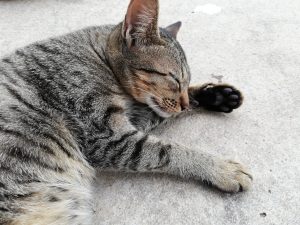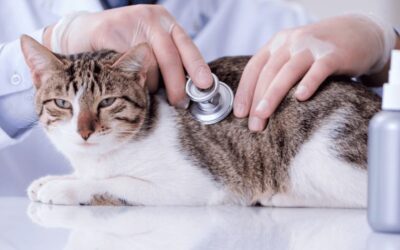Cat Arthritis [Causes, Symptoms & Treatment]

What is Arthritis in Cats?
Arthritis is a degenerative joint disease that causes inflammation, pain, and stiffness in the affected joints. Cats can develop various forms of arthritis, including osteoarthritis, rheumatoid arthritis, and post-traumatic arthritis. Understanding the causes, symptoms, and available treatment options is crucial for providing the best care for your feline friend.
Causes and Risk Factors of Arthritis in Cats
Joint Development Abnormalities
Some cats may be born with joint development abnormalities, such as hip or elbow dysplasia, which can predispose them to arthritis later in life. These structural issues can lead to increased wear and tear on the joints, ultimately resulting in the onset of arthritis.
Wear and Tear
As cats age, the cartilage that cushions their joints can wear down, leading to bone-on-bone contact and the development of osteoarthritis. This gradual deterioration of the joint structures is a natural part of the aging process and can be exacerbated by factors such as obesity and physical activity levels.
Trauma or Injury
Cats can also develop arthritis as a result of previous injuries or trauma to their joints. A sudden impact, such as a fall or a car accident, can damage the joint structures and increase the risk of developing post-traumatic arthritis.
Inflammatory Conditions
Certain inflammatory conditions, such as immune-mediated polyarthritis, can also contribute to the development of arthritis in cats. These conditions cause the body’s immune system to attack the joints, leading to inflammation and joint damage.
Age and Breed Predisposition
As cats age, they become more susceptible to developing arthritis. Additionally, some cat breeds, such as Maine Coons, Persians, and Siamese, may be more predisposed to certain types of arthritis due to their genetic makeup.
Obesity and Nutrition
Excess weight can put additional stress on a cat’s joints, increasing the risk of developing arthritis. Maintaining a healthy weight and providing a balanced, nutrient-rich diet can help reduce the strain on the joints and potentially slow the progression of the condition.
Symptoms of Arthritis in Cats
Recognizing the signs of arthritis in cats is essential for early detection and effective treatment. Here are some common symptoms to look out for:
- Limping and Changes in Gait: Cats with arthritis may exhibit a limp or an altered gait, such as reluctance to put weight on one or more limbs.
- Reduced Mobility and Activity Levels: Arthritic cats may become less active, avoid jumping or climbing, and spend more time resting or sleeping.
- Reluctance to Jump or Climb: Cats with arthritis may avoid jumping onto furniture, climbing stairs, or accessing their favorite high perches.
- Behavioral Changes and Lethargy: Arthritic cats may become more irritable, less interactive, or show signs of lethargy and decreased energy levels.
- Changes in Grooming Habits: Cats with arthritis may have difficulty reaching certain areas of their body, leading to changes in their grooming habits, such as matted fur or unkempt appearance.
Diagnosing Arthritis in Cats
Diagnosing arthritis in cats typically involves a combination of physical examination, imaging tests, and, in some cases, laboratory tests. Here’s a closer look at the diagnostic process:
Physical Examination
During a physical examination, your veterinarian will assess your cat’s joint mobility, range of motion, and any signs of pain or inflammation. They may also palpate the joints to detect any abnormalities or swelling.
X-rays
Radiographic (X-ray) imaging can provide valuable information about the condition of your cat’s joints. X-rays can reveal joint space narrowing, bone spurs, and other structural changes associated with arthritis.
MRI or CT Scans
Your veterinarian may sometimes recommend advanced imaging techniques, such as magnetic resonance imaging (MRI) or computed tomography (CT) scans, to obtain a more detailed and comprehensive view of the affected joints.
Treatment Options for Arthritis in Cats
When it comes to treating arthritis in cats, there are several different approaches that veterinarians may recommend. The specific treatment plan will depend on the severity of the condition, the underlying cause, and the individual cat’s needs.
Medications
One of the most common treatments for arthritis in cats is medication. Veterinarians may prescribe non-steroidal anti-inflammatory drugs (NSAIDs) to help reduce inflammation and alleviate pain. These medications can be given orally or in the form of injections. Additionally, some veterinarians may recommend the use of pain relievers, such as acetaminophen or tramadol, to help manage the discomfort associated with arthritis.
In some cases, veterinarians may also prescribe supplements, such as glucosamine and chondroitin, to help support joint health and reduce the progression of the condition. These supplements can be given in addition to other medications or as a standalone treatment.
Surgical Interventions
In more severe cases of arthritis, veterinarians may recommend surgical interventions to help manage the condition. These procedures can include:
- Joint Replacement: In some cases, veterinarians may recommend a total joint replacement, where the damaged joint is replaced with an artificial one. This can help to restore mobility and reduce pain.
- Arthroscopy: This minimally invasive procedure involves the use of a small camera to examine the joint and make any necessary repairs, such as removing damaged cartilage or repairing torn ligaments.
These surgical interventions can be effective in managing arthritis, but they are typically reserved for cases where more conservative treatments have not been successful.
Preventive Measures for Arthritis in Cats
While there is no way to prevent arthritis in cats completely, cat owners can take several steps to help reduce the risk and manage the condition.
Early Detection and Treatment of Injuries
One of the most important preventive measures is to ensure that any injuries or joint problems are detected and treated early. This can help prevent the development of arthritis later in life. Cat owners should be vigilant in monitoring their cats’ mobility and joint health and seek veterinary care at the first sign of any issues.
Managing Weight And Nutrition
Maintaining a healthy weight is also important for preventing and managing arthritis in cats. Excess weight can put additional stress on a cat’s joints, exacerbating the condition. Cat owners should work with their veterinarian to ensure their cat receives a balanced, nutritious diet and maintain a healthy weight.
Regular Exercise and Joint Health Maintenance
Regular exercise and activities promoting joint health can also benefit cats with arthritis. This can include low-impact activities, such as gentle playtime, swimming, or using cat-specific exercise equipment. Additionally, cat owners can work with their veterinarian to develop a joint health maintenance plan, which may include the use of supplements or other therapies.
The Cost of Treating Arthritis in Cats
The cost of treating arthritis in cats can vary depending on the severity of the condition and the type of treatment required. Medications, such as NSAIDs or pain relievers, can range from $10 to $50 per month, while supplements like glucosamine and chondroitin may cost $20 to $50 per month.
Surgical interventions, such as joint replacement or arthroscopy, can be more expensive, with costs ranging from $2,500 to $5,000 or more. Additionally, cats may require ongoing veterinary care and monitoring, which can add to the overall cost of treatment.
It’s important for cat owners to work closely with their veterinarians to develop an effective and affordable treatment plan. Some veterinary practices may offer payment plans or other financial assistance options to help make the cost of treatment more manageable.
Can Odie Pet Insurance Provide Coverage for Such an Investment?
Depending on the specific policy, pet insurance can cover the diagnosis, treatment, and management of feline arthritis.
Reimbursement
This method is the most common for pet insurance companies. You pay out of pocket for the veterinarian bill, and then the insurance company reimburses you for what’s covered under the insurance plan. The steps look like this.
- You pay the vet bill after your cat’s visit.
- You fill out the pet insurance claim form.
- Submit the claim form and other required documentation to the insurer.
- After the claim is approved, you will be reimbursed for eligible expenses.
What Does Odie Pet Insurance Cover?
Pet insurance covers various veterinary expenses, providing financial protection and peace of mind for pet owners. Here are the details of the coverage options offered by Odie Pet Insurance:
Illness & Injury Plan
The Illness & Injury Plan is an all-inclusive insurance plan designed to cover a wide range of medical needs for your pet. This plan includes comprehensive coverage for various illnesses, injuries, and veterinary services. Some of the covered items include:
- Veterinary exams and consultations
- Diagnostics (e.g., X-rays, lab tests)
- Prescribed medications
- Surgeries and hospitalization
- Rehabilitation, acupuncture, or chiropractic treatments
- Medically necessary supplies
- Euthanasia and cremation
The Wellness Plan
The Wellness Plan is a monthly membership that focuses on preventive care and covers routine veterinary services.
- Provides reimbursements for routine care items such as wellness visits (exams and vaccines), testing and parasite prevention, dental cleanings and at-home dental care, vitamins, supplements, and more.
- Through Odie’s partnership with Petivity, a leader in smart pet products and proactive care, Wellness Plan members can also receive reimbursements for Petivity devices and health kits, as well as eligible Purina food and supplements.
- Total reimbursement up to $700 per year.





